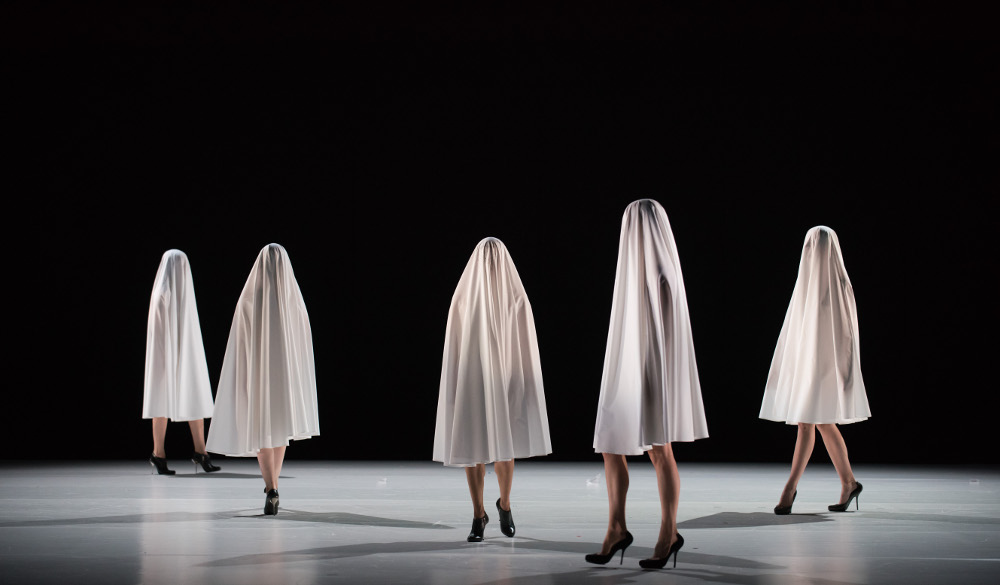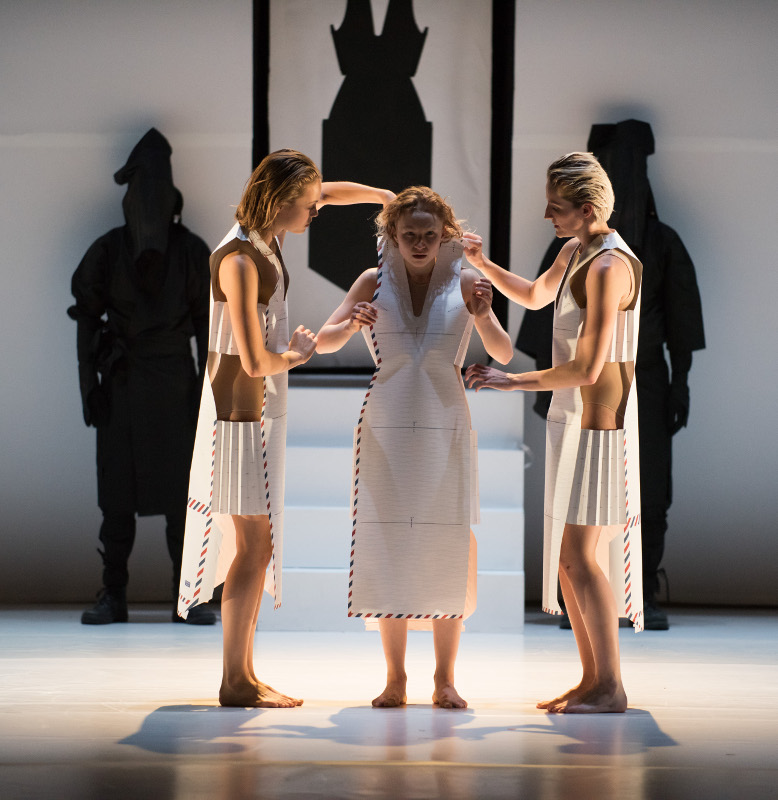If you thought the era of the impresario died with Diaghilev, think again. Alistair Spalding, chief executive of Sadler's Wells, has commercial and artistic vision in spades, and masterfully combines them in his operation at the Wells. Witness last night's show, Gravity Fatigue: inviting a fashion designer, even one as visionary as Hussein Chalayan, to create a dance show might seem like a risky (and expensive) venture, but the theatre was packed to the rafters, fashiony types mingling with the theatre's usual dance audience and all convinced they had come there for a major Artistic Event.
It was certainly an unclassifiable one. Gravity Fatigue hovers at the intersection of contemporary dance, art installation and fashion show, and works best if you judge it on its own terms, rather than by the standards of any particular genre. Each of its 18 segments sits somewhere between a scene and a tableau, a conceptual unity of clothing, set, music and movement. Many of them are clever, funny and wonderfully memorable: the less clever and funny ones are, fortunately, also forgettable, making for a show which I feel greater goodwill towards in retrospect than I did while sitting through its duller parts. The striking visuals are the show's main strength: the aural – courtesy of "sound illustrators" MODE-F – is by and large electronic wall-painting which I am quite happy not to be able to remember in any detail.
 For the dance, Chalayan worked with choreographer Damien Jalet, whose trademark whirling pops up in several places, most strikingly for a stunning sequence in which bulky black overcoats are transformed into sequinned dresses while their wearers spin languidly, creating moving circular tracks of light like disco-styled whirling dervishes. The gravity fascination proclaimed by the title comes up in breakdance-like floorwork, in one instance on a rotating disc of light that makes it look like the dancers are b-boying on an LP, in another with the help of a disguised trampoline in the floor that enables them to throw themselves down on their backs and bounce up again. Chalayan turns the floor into a character in its own right, using a false stage to change its texture and movement quality multiple times, from the above-mentioned trampoline to pools of water, to a pool of a patent-black balls in which a group of people, including two women in burqas, soar and slide with magical ease.
For the dance, Chalayan worked with choreographer Damien Jalet, whose trademark whirling pops up in several places, most strikingly for a stunning sequence in which bulky black overcoats are transformed into sequinned dresses while their wearers spin languidly, creating moving circular tracks of light like disco-styled whirling dervishes. The gravity fascination proclaimed by the title comes up in breakdance-like floorwork, in one instance on a rotating disc of light that makes it look like the dancers are b-boying on an LP, in another with the help of a disguised trampoline in the floor that enables them to throw themselves down on their backs and bounce up again. Chalayan turns the floor into a character in its own right, using a false stage to change its texture and movement quality multiple times, from the above-mentioned trampoline to pools of water, to a pool of a patent-black balls in which a group of people, including two women in burqas, soar and slide with magical ease.
The versatility, or perhaps multivalence, of surfaces is a characteristic of his costume designs as well. The transforming dress/overcoats are part of a general desire to blur the boundaries between insides and outsides. Sometimes this is expressed in impeccable tailoring – as in the overcoats, or swimming costumes which are cut in one with towels or dressing gowns – and sometimes it's more conceptual: a runway show for instance, in which a voiceover describes sumptuous outfits, but the models are actually draped in sheets (pictured above).
 Many of the costumes also comment on what fashion is, and the agency (or passivity) of clothes: identical pre-cut paper dresses (pictured left) which fly away into the distance after just one wear, dresses which seem to move of their own accord, and in one noirish sequence worthy of a Lady Gaga video, a dress which moves like it has a python inside it, forcing its wearer to totter on her heels while three vampish ladies practically climb on tables to get a better look at her.
Many of the costumes also comment on what fashion is, and the agency (or passivity) of clothes: identical pre-cut paper dresses (pictured left) which fly away into the distance after just one wear, dresses which seem to move of their own accord, and in one noirish sequence worthy of a Lady Gaga video, a dress which moves like it has a python inside it, forcing its wearer to totter on her heels while three vampish ladies practically climb on tables to get a better look at her.
Amid all this wit and ingenious design, the elastic tubes featured so heavily in the publicity shots (main picture) actually fall rather flat; the dancers can't move smoothly enough in them to give credence to the title 'Elastic Bodies'. This is not the only case where design concepts seem to have outridden the dancers' ability to work with them; a sequence with ropes has the same problem of impeded movement and as a result loses its ability to fascinate.
These stutters are one of the elements that make Gravity Fatigue, if viewed as a dance show, substantially sub-Pina Bausch. Bausch is famous for her un-dancefloor-like surfaces (earth; water; grass), but got from her dancers a far more total engagement with them than do Chalayan and Jalet. Lacking the warmth and full-heartedness one associates with Bausch, Gravity Fatigue feels like it's keeping something in reserve – under wraps, perhaps. That may be appropriate for a show which is concerned, its director says, with "disembodiment...displacement [and] isolation" but it earns Gravity Fatigue in the end a rather more respectful than rapturous response.
- Gravity Fatigue at Sadler's Wells tonight, 30 October














Add comment